#gaelpol
Text
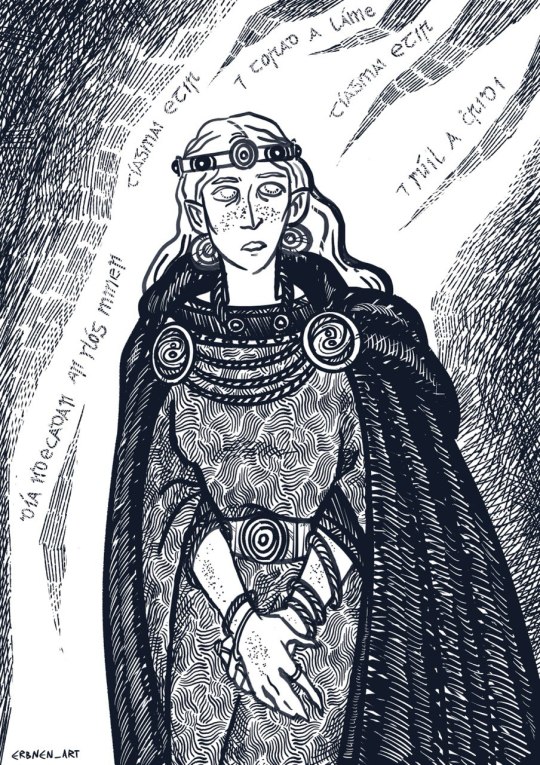
A commission of Brigid for @bloodtreachery (awww, it was SUCH a pleasure to do it!). I put an emphasis on her aspect as a poet, hence the fire of poetry ablaze!
The poem in the flames is a liberal translation of these lines from The Hosting of the Sidhe into Old Irish (courtesy of my wonderful husband):
...if any gaze on our rushing band,
We come between him and the deed of his hand,
We come between him and the hope of his heart.
#artists on tumblr#irish mythology#brighid#brigid#celtic paganism#gaelpol#paganblr#pagan art#illustration#commission#commissions open#tuatha de danann#irish goddesses#goddess brigid#druidism#celtic deities#aodhan erbnen
328 notes
·
View notes
Text
Semi-regular reminder that Gaelic polytheism is not a closed practice. You do not need to be from Ireland, Scotland, or Man or have any “Celtic blood” to worship the Gods, Ancestors, and Spirits
Anyone who tells you different is misinformed at best or probably a racist at worst
183 notes
·
View notes
Text
Something that gets left out in some eclectic discussions of the celtic fire festivals is that they are the end of one season and the start of another
Imbolg- Start of Spring
Bealtaine- Start of Summer
Lúnasa- Start of Autumn
Samhain- Start of Winter
Which makes sense because in Ireland the seasons are generally defined as:
Spring – February, March, April
Summer – May, June, July
Autumn – August, September, October
Winter – November, December, January
Like if you went up to a random person in Ireland today and asked them what season February is in they’d say Spring.
Seasons are obviously different across the world, in fact many places don’t have 4 seasons so the misunderstanding makes sense but seeing people frame Imbolc as “Oh its not a spring festival its the just bringing back of light” is just factually wrong.
#féile#irish paganism#gaelic paganism#celtic paganism#Irish polytheism#gaelic polytheism#celtic polytheism#gaelpol#iripol#witch#I think other places use the solstaces/equinoxes?#this is a weirdly common thing tho#magic#ireland#mine#witchblr
212 notes
·
View notes
Text

THE LIVES OF ÉTAÍN
This piece depicts the themes and symbols around the character of Étaín from Tochmarc Étaíne and her various transformations throughout the tale. The two faces depict Étaín's two incarnations a thousand years apart, flanked by suns and moons to represent that "all time is made up of days and nights." The swan and fly represent Étaín's two animal forms, while the cup and pitcher represent the cup of the wife of Étar, and Étaín's skill at serving drink, by which Eochaid seeks to recognize her. Finally, the vegetation and swirling billows on the outside of the frame symbolize the "fragrant and wonderous herbs" of Aengus's crystal sun-bower, and Fuamnach's magical winds.
This was my submission to the late Ralph Kenna's EÍRÍ art project through the Irish Post in 2022, based on the prompt of Evoking Ireland's Resiliant Female Icons. The Wooing of Étaín is one of my favorite Irish myths, and I've always wanted to take a crack at representing some of the themes of the story.
Hello everyone, it's been quite a while! I've been on a bit of an impromptu hiatus due to general life stuff and a bit of artistic burnout in the last year or so, but I've got a few works in progress that I'm hoping will help get me back into the swing of things!
#celtic#celticart#mythology#irish mythology#celtic mythology#folklore#etain#midir#aengus#aengus mac og#tochmarc etaine#gaelpol#pagan#pagan art#goddess#forfedaproject
53 notes
·
View notes
Text
So as far as I'm aware in the Celtic umbrella of deities we don't have any deities SPECIFICALLY related to weaving/textiles or pottery. Which in the grand pattern of Indo-European branches (or even humanity as a whole) seems.... very odd...
What are the community's thoughts on these acts falling under the purview of Brigit or her other language counter parts? Are there other deities that would make more sense for these activities? What are our thoughts?
#gaelpol#gaelic paganism#gaelic polytheism#gaelic deities#celtic#celtic paganism#celtic polytheism#celtic deities#Irish#irish paganism#irish polytheism#irish deities#gaulish#gaulish polytheism#Gaulish paganism#Gaulish deities#brigid#brighid#brigit#bríg#bríd#*Brigantī#Brigantia#Brigindo
61 notes
·
View notes
Text
What are some daily rituals you try to do every day? - however short and simple or long and complex they might be. I would love to hear them!
I’m trying to build my own daily and weekly rituals where I set aside time for my deities.. And I’m having trouble figuring out the “best” way to do so. Just looking to see what other’s experiences are like.
#Gaelpol#Polytheism#lokean#brighidine#irish polytheism#gaelic paganism#gaelic polytheism#deity worship#deity work#paganblr#heathenry#Loki#Brighid#loki deity#brighid deity#rituals
38 notes
·
View notes
Text
does anyone have any scholarly book recs to learn about the Irish diaspora in North America? bonus points for a focus on folklore and tradition
#iripol#gaelpol#irish paganism#gaelic polytheism#irish polytheism#much appreciated; i simply havent come across what im looking for yet#outside of smaller sources#scottish diaspora id be interested in too
27 notes
·
View notes
Text
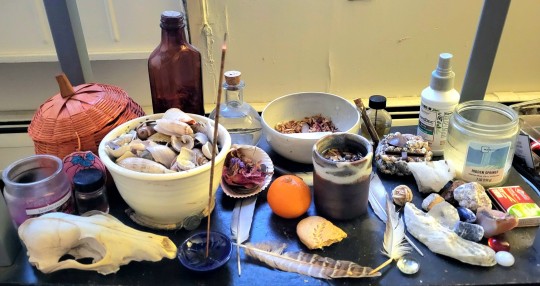
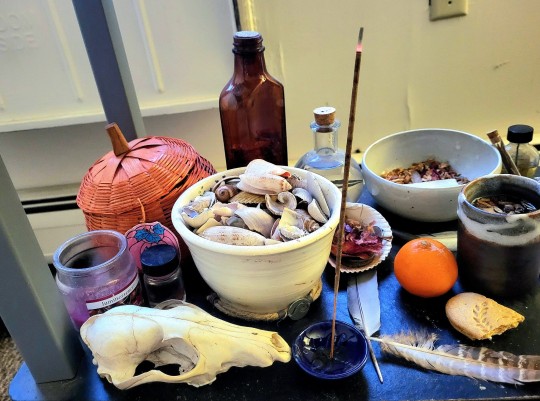
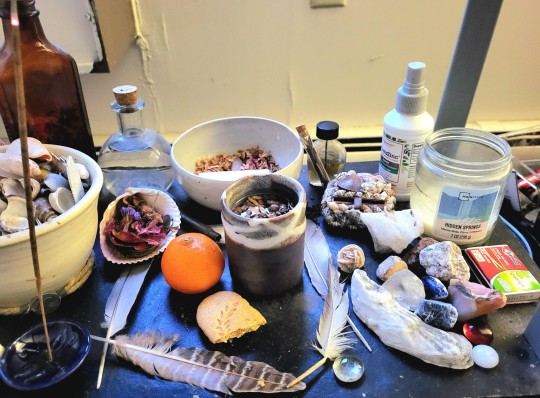
manannán mac lir altar update! there's a cat in the house now, so I had to rearrange the whole shelf, including moving my altar our of her little paw's reach.
19 notes
·
View notes
Text
I originally made this post for instagram for lá fhéile Pádraig but yall seem to enjoy my book recommendations so I'm posting it here too

"Lá Fhéile Pádraig shona daoibh! Happy St. Patrick's day! I've seen some people posting their Irish-related books to combat the 'Plastic Paddy' version of Irish culture that's so pervasive here in the U.S. so I'm hopping on the...trend? I've only seen like 3 people do it tbh. Here's some (but not all) of my favorite Irish & Celtic Studies related books!
1. "Defiant Irish Women" by Eddie Lenihan
2. "Irish Fairy and Folk Tales", Fall River Press
3. "The Celtic Revolution: A Study in Anti-Imperialism" by Peter Berresford Ellis
4. "An Old Woman's Reflections" by the amazing Peig Sayers
5. "North", a collection of poems by Seamus Heaney
6. "The Book of Irish Curses" by Patrick C. Power
7. "Irish Customs and Rituals: How Our Ancestors Celebrated Life and the Seasons" by Marion McGarry
8. "The Course of Irish History", Mercier Press
9. "Gods And Fighting Men" by Augusta Lady Gregory
10. "The Morrigan: Celtic Goddess of Magick and Might" by Courtney Weber
11. "The Druids" by Peter Berresford Ellis
12. "Ireland: A Graphic History" by Morgan Llewellyn and Michael Scott"

+ honorable mentions I'd put in my story that day
146 notes
·
View notes
Text

made this little patch for Caer Ibormeith and Aengus mac Og! im very happy with it :)
20 notes
·
View notes
Text
I’m doing a study program with my group that involves 5 months of regular meditation and mental discipline practice and I’m curious to see what others think about it! Please rb with your definition of what meditation is!
#meditation#pagan#paganism#witch#witchcraft#poll#gaelic polytheism#irish polytheism#celtic paganism#recon#hellenic polytheism#helpol#gaelpol#hellenic paganism#norse polytheism#heathenry#germanic paganism#spiritual#kemetic#kemetic polytheism#slavic polytheism#gaulish polytheism#druidry#druid
22 notes
·
View notes
Text

Bodb Derg son of Dagda, High King over the Tuatha Dé Danann.
#i can’t paint to save my life#but I tried#bodb derg#irish mythology#tuatha de danann#gaelpol#artists on tumblr#celtic paganism#irish paganism#celtic deities#paganblr#pagan aesthetic#bodb dearg#eire#celtic mythology#aodhan erbnen
102 notes
·
View notes
Text
I take a sort of “rule of cool” approach to my pagan faith. I use archaeology and history as my baseline, and I freely incorporate elements from folklore and superstition to fill in the gaps. However, I think there’a an argument to be made that if we want Gaelic paganism to thrive as a living religion, we have to allow innovation and reinterpretation. Do we have any proof of Ogham being used for divination? Nothing concrete. Is it cool and do I still do it tho? Fuck yeah.
As long as you’re honest about what’s historically attested, what is speculative, and what is newly created, I don’t see why old and new can’t coexist. They do in my faith anyway.
Fuck that neo Druid and Celtic shaman shit tho. Get that shit right tf outta here.
#not to shit on strict recons#I admire that approach#gaelpol#gaelic polytheism#gaelic paganism#paganism#irish polytheism#polytheism#this post does not include wiccans and neo druids
31 notes
·
View notes
Note
Forgive me if this is a foolish question, but would you happen to know if there’s any sources out there on historical prayer behaviors? IE body position, gestures, etc. I don’t come from a religious background, so I struggle to know to go about praying even when I know what I want to say
Gestures and actions during Irish/Gaelic Pagan prayer.
This is not a foolish question at all! In fact it is a great one. Honestly finding the right words is the hardest part. There is little in the way of documented proof of how pre christian Gaels prayed so reconstruction is necessary. This makes it tricky to find authentic sources, thankfully there is a few practice's we can reconstruct with a lot of certainty. (Sources in bracketed links)
Clockwise/Deiseal movement
The act of moving in a circle in a clockwise direction (deiseal) is frequently seen to be auspicious and is used in many Irish Christian rituals. Many of these practices are still done today, especially at holy wells or other pilgrimage sites such at the various stations on Croagh Patrick (link). The opposite of this is anti-clockwise or Tuathal is frequently used in curses. This is a recurring theme throughout Irish and Scottish folklore and has been argued to be partially of a pre Christian origin(Link to book containing a chapter on the topic specifically chapter 10)
This is usually done at Holy Wells while doing the rosary. The well itself or an object near it like a statue, rock or tree is encircled by the worshiper usually 3 or 7 times while reciting the rosary. (link)(link)(link). And is a still living practice.
This clockwise movement was also used in medieval rituals, with supposedly in the Book of Fenagh, an inauguration ritual is described where a bell shrine was walked around a king and his solders clockwise. (in book chapter 10).
The use of the word deiseal and its association with blessing led it in the past to be an equivalent to "bless you" after a sneeze. (link). The sunwise or clockwise direction is synonymous with blessings.
Head down, eyes up
The Carmina Gadelica contains a number of prayers from gaelic scotland. Many of which follow a standard christian practice and just as many are situational in nature like to be said while washing ones hands, however certain ones stand out as being representative of a greater traditions of actions due to their unusualness.
References to raising ones eyes (link) and leaving the palms open and outstretched are mentioned (link page 290)
Both women and men were said to curtsey with men doing a bowing motion much like a curtsey in that it involved the bending of the left knee to the side and the right one straight as a show of respect (link)
To summarise with a quote:
"So the lifting of hands, raising of the eyes, and the bowing of the head are all actions that could be done during our prayers. In raising our hands we show a gesture of giving, just as we ‘give’ prayers of thanks, or blessing, or whatever other purpose we might be praying for, especially since there seems to be a since that we’re meant to raise the palms up to the sky (or moon, more to the point) instead of simply holding our hands out, palms up. It’s less a gesture that might suggest we’re asking for a handout than it gives a sense that we’re reaching out."
-An Introduction To Gaelic Polytheism by Marissa Hegarty
Curse pose
While not involved with worship, poets when preforming a satire, often magical in nature were said to stand on one foot, with one eye closed, holding up one hand, and sometimes speaking with one breath. This seems to specifically used for cursing however.
What to incorporate into your pagan practice
I would then recommend that while praying, walking in a circle in a clockwise direction with a bowed head, eyes up, while holding out your hands with the palms skyward would be appropriate. I like to have one hand over the other. After the prayer has concluded a curtsey should be done.
If anyone else has anything to add please do so with what gestures and actions you take during prayers. I hope this answers your question and that it was at all helpful.
#mine#ceist#draíocht#gaelic paganism#celtic paganism#irish paganism#irish polytheism#gaelic polytheism#celtic polytheism#pagan#magic#prayer#paganism#witch#witchblr#research based paganism#please anyone share how you do it#sometimes a direction can be so important to someone that person is me#resources#gaelpol#also check out the two books ive linked#celtic#ireland#scotland#if anyone can source any examples from irish mythology or early lit that would be great#ive seen someone stuff but i can't source it so I did not include#especially deiseal related stuff
85 notes
·
View notes
Text
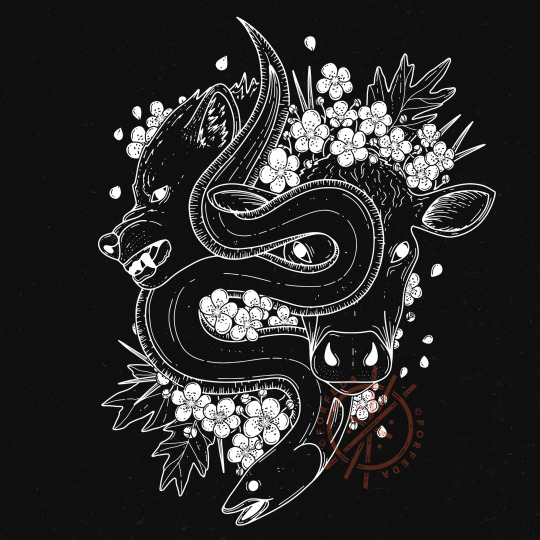
PHANTOM AT THE FORD
"I will come against you in the form of an eel about your feet in the ford, so that you shall fall…
I will drive the cattle on the ford to you, in the form of a grey she-wolf…
I will come to you in the form of a hornless red heifer before the cattle. They will rush on you on the plains and on the fords, and on the pools, and you will not see me before you…"
- The Morrígan to Cú Chulainn, Táin Bó Cúailnge
In the Táin Bó Cúailnge ("the Cattle Raid of Cooley"), the warrior Cú Chulainn is able to stave off the advances of Queen Medb's army by invoking his right to single combat at the fords, singlehandedly defeating each of Medb's champions in turn. But when Cú Chulainn refuses help from the Morrígan, a powerful goddess, she resolves to instead be a hindrance to him, taking different animal forms to disrupt his battles - an eel to trip him, and a wolf and a heifer to drive the cattle over the ford.
This piece depicts the three forms of the Morrígan surrounded by the thorns and flowers of the hawthorn, a tree connected to terror, baneful magic, and the powers of the Otherworld in Gaelic folklore.
#celtic#celticart#mythology#irish mythology#celtic mythology#folklore#morrigan#cu chulainn#shapeshifter#tain bo cuailgne#ulster cycle#hawthorn#deity#gaelpol#pagan#pagan art#goddess#forfedaproject
193 notes
·
View notes
Text
Are there any deities that are associated with mushrooms/fungi?
#norse polytheism#hellenic polytheism#helpol#gaelic polytheism#gaelpol#celtic polytheism#kemetic polytheism#polytheism#paganism#norse paganism#hellenic paganism#gaelic paganism#irish polytheism#irish paganism#celtic paganism#kemetic paganism#welsh polytheism#welsh paganism#gaulish polytheism#gaulish paganism#roman polytheism#roman paganism#slavic polytheism#slavic paganism#mushrooms#fungi#funguary
4 notes
·
View notes